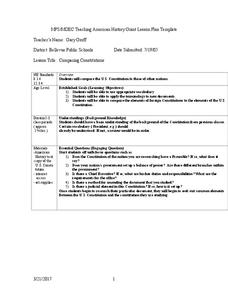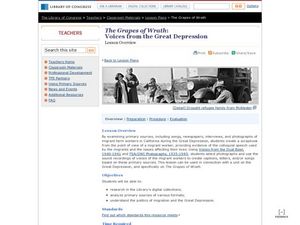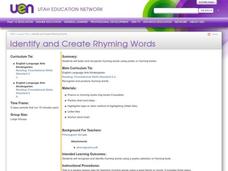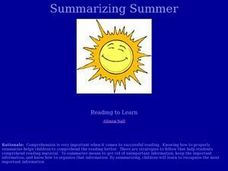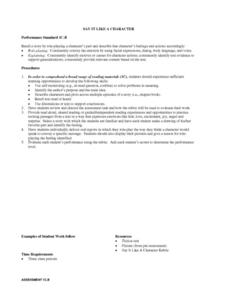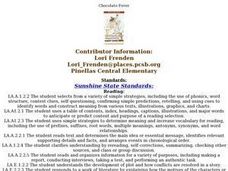Curated OER
Friendly Patter Poetry
Students create a free from poem on the topic of friendship. They read examples of free form poetry to gather ideas. Through the use of a graphic organizer, students generate a list of friendship characteristics which is used to create...
Curated OER
Valuable Veterans
Students select one female veteran and research her background and contribution to the military. They explore the relationship between women and the military and how it has evolved since the Revolutionary War.
Curated OER
Comparing Constitutions
Students compare and contrast plans for government. In this government systems lesson, students compare and contrast the U.S. Constitution to the constitutions of selected countries using the provided checklist as a guide. Students...
Curated OER
KS3 Bitesize
Students complete exercises using their five senses to improve their writing skills. In this writing skills lesson, students complete activities blindfolded and using their five senses. Students then select an abstract noun and describe...
Curated OER
The Grapes of Wrath: Voices from the Great Depression
Students research the Great Depression. In this Great Depression lesson, students analyze primary sources to develop an understanding of the plight of migrant farm workers during the Great Depression as they read Steinbeck's The...
Curated OER
Public Demonstrations - Lesson Plan
Learners examine various handouts to determine the value, necessity and potential limitations of assembly and public demonstrations. They then select a side and debate pre-provided questions.
Curated OER
Local Retreats
Students consider how their favorite local places might be interesting spots for visitors. They investigate and write articles on these locations to examine what their community has to offer and to create an Unlikely Tourist's Guide to...
Curated OER
Holes, by Louis Sachar
Students use reading fluency, comprehension, vocabulary, written expression to write in journals as reading "Holes" by Louis Sachar. Some days are set aside for tests and/or food tasting.
Curated OER
Identify and Create Rhyming Words
Students discuss rhyming word families and read stories that present those families in rhyme. They generate rhyming words, manipulate sentence strips to pair rhymes and sort pictures of rhyming words.
Curated OER
CHICKEN LICKEN
Second graders examine the cover of the book, CHICKEN LICKEN and make predictions about what will happen in the story. They read the book understanding that is a cautionary tale. They read the story again focusing on the repeated refrains.
Curated OER
Flow Charts
Students explore the use of flow charts and cyclical diagrams. They discuss how to read the charts. Students produce a simple flow chart or diagram to explain a process. They investigate various methods used to present text.
Curated OER
Summarizing Summer
Fourth graders summarize a piece of text. After reviewing the correct way to read in order to summarize, 4th graders independently read a selection of their choice. They write a summary paragraph using the graphic organizer outlined by...
Curated OER
Summarizing to Understand!
Students review the concept of silent reading. Through modeling and guided practice, they follow six given steps in summarizing a written passage. Then they read a passage independently and follow the same steps in summarizing the...
Curated OER
The Map of Summarization
Learners review the concept of silent reading. Through modeling and guided practice, they follow six given steps in summarizing a chapter from "Charlotte's Web." Then they follow the same steps in summarizing the next chapter on their own.
Curated OER
Book Box
Students create a bookmark, book cover and book review for a book they read. In this nutrition meets literacy lesson, students read a book about food and complete creative projects based upon the book. Some of the ideas included in this...
Curated OER
Starring...Bears!
Students illustrate a First Nations' legend. In this legend of bears instructional activity, students read several legends which involve bears and groups of stars or constellations. After reading, students illustrate portions of the...
Curated OER
Examining newspapers
Students compare and contrast tabloid and broadsheet papers. In this journalism lesson plan, students examine how techniques and form differs from one type of publication to the other. The culminating activity is for students to take...
Curated OER
Say It Like A Character
Young scholars read a story and retell it to the class by role-playing one of the characters. In groups, they use the correct facial expressions along with body language and voice to convince the others in their group that they are...
Curated OER
Comparing Fairy Tales
Students read and review common fairy tales and come up with a list of characteristics from them. The Teacher models filling out either a compare & contrast graphic organizer comparing two fairy tales.
Curated OER
"Wheels, Wings and Other Things"
Learners participate in various reading and writing activities related to the book "Wheels, Wings and Other Things" by Monica Hughes and Barbara Hunter. They participate in a shared reading activity, and write a new page for a book...
Curated OER
Visualizing Trees
students draw what they visualize after the teacher reads a page from the book Oak Trees. They share their pictures and compare how they visualized the tree being described.
Curated OER
Chocolate Fever
Fourth graders read and interpret each chapter of the book in small groups through various exercises. Vocabulary lists are given, as well as rubrics, quizzes and activity sheets. Students create their own PowerPoint presentations to...
Curated OER
Let's be Star Summarizers
Third graders summarize a piece of nonfiction text. After reviewing the correct way to read for important information and summarize that information, students independently read a nonfiction article. They write a summary paragraph using...
Curated OER
Sensational Summarizers
Students study strategies that aid comprehension. They focus on the main ideas of a passage and eliminate unnecessary and repetitive information. They substitute super ordinate terms for a list of items and create a topic sentence.




